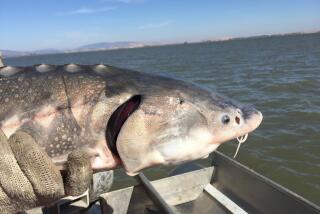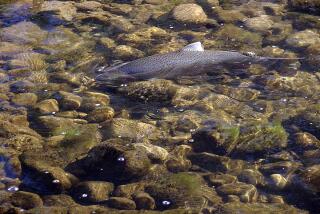Fishermen Experiment With Lines to Catch Makos : Sharks: A few commercial anglers are licensed to use the special tackle. Regulators are concerned about population depletion.
To stem the indiscriminate taking of sharks off the California coast, six Ventura County commercial anglers are experimenting with a fishing method considered one of the most selective ever devised.
The six, along with two other Southern California fishermen, target mako sharks using baited hooks rigged to steel cables up to four miles long, suspended at a 30-foot depth by a series of buoys.
The method is far more selective than gill netting, which yields an unrestricted number of sharks as an incidental catch, and which is blamed for a recent drop-off in the thresher shark population.
Unlike gill-netters--whose catch is usually dead and cannot be thrown back--the long-liners are subject to annual landing quotas, release undesired species such as blue sharks alive, and tag and release undersized makos for biological study.
“It is a very clean fishery,” said Gene Fleming, a marine resources supervisor with the state Department of Fish and Game, which has licensed the long-liners on an experimental basis each of the last four years.
“This has been one of the most well-managed fisheries since its inception,” said David Holts, a federal biologist with the Southwest Fisheries Center in La Jolla. “The idea is to prevent overfishing and find an alternative to drift nets to minimize the unintended catch of mammals, turtles and other things that are caught and discarded.”
Once the seemingly indestructible marauders of the deep, sharks have been dwindling in number off the nation’s coasts in recent years, as the ocean’s most feared carnivore increasingly becomes table fare.
Studies have found that overfishing has caused an alarming population drop in several species in the Atlantic. The growing popularity of shark meat has led to similar, though lesser, declines in California’s coastal waters.
The soupfin shark was the first casualty of overfishing, virtually wiped out in the 1940s for its Vitamin A-rich livers, Holts said. Stocks have never recovered.
Curbs placed on thresher shark fishing have cut the annual catch from a peak of 2.3 million pounds in 1982 to 400,000 pounds last year. Despite the reduced take, Holts said, the average shark caught has dropped in size from 12.4 feet in 1981 to 10 feet in 1989.
And the annual catch of angel shark, marketed as a fish-and-chips alternative to cod, fell to 250,000 pounds last year from more than 1 million pounds in 1986 because of population declines, a shortened fishing season and minimum-size restrictions.
The mako, prized both for food and as an aggressive sport fish, has so far withstood the onslaught. Neither the average size of the commercial catch nor the number of fish caught per 100 hooks has dropped in the last five years.
“We don’t want the fishery expanded much beyond where it is now,” said Tim Athens, 35, of Oxnard, one of the eight licensees and executive secretary of the California Shark Driftline Assn. “But we want to get this legislated into a legal fishery and get out of the experimental mode.”
Seeking to avoid mistakes of the past, state regulators are more cautious about expanding the fishery and possibly leaving a decimated mako population in the wake.
Like other shark species, makos are vulnerable to overfishing because they are reproductive late bloomers. Males do not reach sexual maturity until 4 years old, and females do not reproduce until 5 to 8 years.
Since the vast majority of makos caught off California are juveniles, less than three years old, the full effect of the mako fishery is not yet known. As for adult makos, they inhabit uncharted waters: Their whereabouts are a mystery.
“No one seems to really know where the juveniles go once they leave here,” Holts said. “It’s amazing that in 1991, we don’t know much about these animals. It’s only been the last 10 years that anyone’s begun looking at them.”
State fish and game officials said the long-liners have been issued provisional licenses each year specifically because little is known of the makos’ breeding and migratory patterns, and thus, of the impact of the 250,000- to more than 600,000-pound annual commercial and sportfishing catch taken since 1982.
“When you’re dealing with shark species, you have to be very careful because of the nature of the animal. It’s slow growing and slow to reproduce,” said John Sunada, a state biologist. “With any type of new fishery, you have to make sure it doesn’t have dire consequences on the population, since the effects sometimes may not be seen for several years.”
The long-line experiment began unofficially in 1983 when novice fisherman Larry Derr began going after mako with a hemp rope line and 40 hooks in waters outside Santa Monica Bay. Derr, at the time a computer technician, said he wanted to devise a means of targeting makos alone.
“I’m a conservationist, and I wanted to come up with a way of taking shark without any by-catch,” said Derr, 36, of El Segundo, one of the eight long-line licensees. “We found we could take shark and only shark, and that if we expanded the amount of gear we used, we could make a living out of it.”
By 1987, Athens said, about 50 commercial fishermen had taken up the method--and alarmed some sportfishermen who feared that their precious marlin would be inadvertent by-catch. State regulators shut the fishery down that fall, forcing Athens, Derr and other long-liners to apply for experimental licenses. The state Fish and Game Commission extended the provisional licenses to 10 fishermen, the six with the largest landings in 1987 and four others chosen through a lottery.
State observers assigned to the long-line shark boats in 1988 and 1989 confirmed that the marlin population was not at risk, primarily because they are smarter than shark.
“Their gear is such that most other species of fish stay away,” said Bob Fletcher, president of the Sportfishing Assn. of California. “You won’t see a marlin eating a dead mackerel on a cable. The shark is of a lower order and driven by genetic instinct. They’re the garbage trucks of the sea.”
The long-liners are not without their restrictions. On July weekends and from August through December, in a compromise to appease the sportfishermen, the long-liners are barred from fishing within a 1,200-square-mile triangle bounded by Point Loma near San Diego, Santa Catalina Island and Point Vicente on the Palos Verdes Peninsula.
They are subject to an annual quota of 175,000 pounds of dressed meat, down from 240,000 pounds two years ago. The current catch is less than half the 403,000 pounds of mako taken by gill-netters last year, Athens said.
Their season runs from May 1 through Dec. 31, extended by three months this year to allow the long-liners to take their quota in off months. Mako sells for as much as $1.70 per pound in the fall, and as low as $1 per pound during summer months, Athens said.
The long-liners were under a commission order to create a market for blue shark, which has accounted for up to 65% of their catch. They collectively sold 40,000 pounds of blue shark last year, but the mandate proved difficult to meet, Athens said, because blues emit urea into their flesh when they die, making them virtually unpalatable.
“You need to bleed them alive and then blast freeze them. There’s so much water content in their meat that freezing dehydrates them a little and makes them firmer, “ Athens said. “Unfortunately, the blue shark’s time has not yet come. At best, they make a poor quality fish-and-chips fish.”
More to Read
Sign up for Essential California
The most important California stories and recommendations in your inbox every morning.
You may occasionally receive promotional content from the Los Angeles Times.










